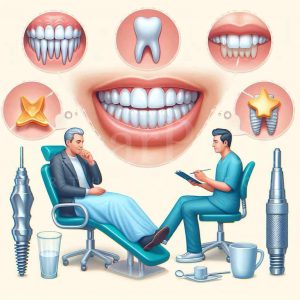Table of Contents
ToggleEmbracing Clear Aligners: A Guide for Dental Implant Patients
In recent years, clear aligners have become a popular choice for teeth straightening.
Their discreet appearance and convenience have made them a preferred alternative to traditional braces.
As more people seek to improve their smiles, the demand for clear aligners continues to grow.
Dental Implants and Orthodontic Treatment
Parallel to the rise of clear aligners, there has been an increase in the number of people opting for dental implants.
These implants serve as a robust and long-lasting solution for missing teeth.
Consequently, a significant number of individuals with dental implants are now seeking orthodontic treatment to further enhance their smiles.
Clear Aligners and Dental Implants: A Compatible Pair?
The central question that arises is: Can I wear clear aligners if I have dental implants?
This is a common concern among patients who wish to straighten their teeth but already have one or more dental implants.
In the following sections, we will delve deeper into this question, exploring the compatibility of clear aligners with dental implants, and providing guidance for those considering this orthodontic option.
Stay tuned as we navigate through this important topic, providing you with the information you need to make an informed decision about your orthodontic treatment.
Addressing the Central Question: Can Clear Aligners Work with Dental Implants?

The Good News: Compatibility of Clear Aligners and Dental Implants
The good news for those considering clear aligners with dental implants is that these two can often work together harmoniously.
This means that having dental implants does not automatically exclude you from the benefits of clear aligners.
This compatibility opens up a world of possibilities for individuals seeking to enhance their smiles, even after receiving dental implants.
The Caveat: Adjustments to Treatment Plans
It is important to note that while clear aligners and dental implants can coexist, treatment plans might need adjustments due to the unique properties of implants.
Unlike natural teeth, dental implants are anchored directly into the jawbone, which means they do not move in the same way natural teeth do.
This immobility of dental implants needs to be taken into account when designing a treatment plan involving clear aligners.
Your orthodontist will need to carefully consider the position of your implants and how they interact with the rest of your teeth.
This might mean that your treatment plan will be more complex and require more careful monitoring than a standard clear aligner treatment plan.
In the next sections, we will delve deeper into these considerations, providing a comprehensive guide for those navigating the intersection of clear aligners and dental implants.
Understanding the Why: The Interplay of Clear Aligners and Dental Implants

The Immobility of Implants: A Unique Challenge
One of the key factors to understand when considering clear aligners with dental implants is the immobility of implants.
Unlike natural teeth, dental implants are fixed in place.
They are anchored directly into the jawbone, providing a stable and robust solution for missing teeth.
However, this stability also means that dental implants cannot be moved in the same way as natural teeth.
Clear aligners work by applying gentle pressure to gradually shift teeth into their desired positions.
However, this pressure is ineffective on dental implants due to their fixed nature.
Shifting Focus: Aligning the Surrounding Teeth
Given the immobility of dental implants, the focus of clear aligner treatment in patients with dental implants shifts to the surrounding natural teeth.
The aligners will primarily work on shifting these teeth around the implant.
This approach allows for the optimization of the overall alignment and appearance of the teeth, even with the presence of one or more immovable dental implants.
It’s a testament to the versatility and adaptability of clear aligner treatment plans.
We’ll explore how orthodontists design and implement these specialized treatment plans, ensuring optimal results for patients with dental implants.
Exploring the Types of Dental Implants

Dental implants come in various types, each designed to cater to specific needs and conditions.
Understanding these types can help you make an informed decision about your orthodontic treatment.
Let’s delve into the most common types of dental implants.
| Types Of Dental Implants | Description |
| Endosteal Implants | Endosteal implants are the most commonly used type of dental implant. They are typically made of titanium and shaped like small screws. These implants are placed directly into the jawbone and provide a strong and stable foundation for the replacement tooth. |
| Subperiosteal Implants | Unlike endosteal implants, subperiosteal implants are not placed in the jawbone. Instead, they are placed under the gum but on, or above, the jawbone. This type of implant is often used for patients who do not have enough healthy natural jawbone and cannot, or do not want to, undergo a bone augmentation procedure to rebuild it. |
| Zygomatic Implants | Zygomatic implants are the least common type. They are used when the patient’s jawbone is not suitable for endosteal or subperiosteal implants. In this case, the implant is placed in the cheekbone (zygoma) instead. |
Most of these types of dental implants have their own advantages and considerations.
Your orthodontist will help you determine which type is best suited to your specific needs and circumstances.
Treatment Options and Considerations: Navigating the Path to a Perfect Smile

Getting Implants First: A Common Approach
In most cases, it is generally recommended to get dental implants first before starting clear aligner treatment.
The primary reason for this is that the position of the dental implant cannot be adjusted later.
Once an implant is placed and integrated with the jawbone, it becomes a fixed point in the mouth.
Therefore, it’s crucial to have the implant in the correct position before starting orthodontic treatment.
Getting Aligners First: A Case-by-Case Basis
While getting implants first is the common approach, there are some cases where getting clear aligners first might be possible.
This largely depends on the specific situation of the patient, including the current alignment of their teeth, the number and location of missing teeth, and their overall oral health.
In such cases, the treatment plan needs careful consideration and planning to ensure successful results.
Consulting a ClearPath Ortho Certified Orthodontist: Your Guide on this Journey
Regardless of the approach you choose, consulting a ClearPath Ortho-certified orthodontist is a crucial step.
These professionals are trained and experienced in dealing with complex cases involving clear aligners and dental implants.
They will assess your specific situation, consider your needs and preferences, and recommend the best approach for you.
Remember, every patient is unique, and what works for one person may not work for another.
Therefore, personalized advice from a certified orthodontist is invaluable in your journey towards a perfect smile.
Additional Considerations: Navigating the Path to a Perfect Smile
Potential for Implant-Related Complications
While clear aligners and dental implants can often work together, it’s important to be aware of the potential for implant-related complications during treatment.
These complications are usually minor and temporary, but they can impact the progress of your treatment.
For instance, the pressure exerted by the aligners on the teeth can sometimes cause discomfort around the implant site.
Additionally, changes in the position of the natural teeth can affect the fit and feel of the implant.
It’s crucial to communicate any discomfort or changes you notice to your orthodontist promptly. They can adjust your treatment plan as needed to ensure your comfort and the success of your treatment.
The Importance of Good Oral Hygiene
Maintaining good oral hygiene is crucial throughout your clear aligner treatment, especially around the implant.
Dental implants, like natural teeth, require regular cleaning to prevent the buildup of plaque and bacteria.
Neglecting this can lead to gum disease, which can complicate your orthodontic treatment and impact the health of your implant.
Ensure you brush and floss regularly, paying special attention to the area around your implant.
Your orthodontist can provide specific advice on how to clean around your implant and aligners effectively. Remember, a successful orthodontic treatment is a team effort.
With the guidance of your orthodontist and your commitment to good oral hygiene, you can navigate the path to a perfect smile, even with dental implants.
Understanding the Cost of Dental Implants in Pakistan

Dental implants are a significant investment in your oral health and overall quality of life.
However, the cost of dental implants can vary widely, depending on several factors. In Pakistan, the price for dental implants can range from 50,000* to 300,000* PKR.
Factors Influencing the Cost
Several factors can influence the cost of dental implants. These include:
| Factors Affecting Cost | Description |
| Type of Implant | As discussed earlier, there are different types of dental implants – endosteal, subperiosteal, and zygomatic. The type of implant used can affect the overall cost. |
| Material Used | The material used for the implant also plays a role in the cost. Implants are usually made of titanium, but other materials may also be used. |
| The Complexity of the Procedure | The complexity of the procedure can significantly impact the cost. For instance, if bone grafting is required before the implant placement, this will add to the overall cost. |
| Geographical Location | The cost of dental implants can also vary depending on the geographical location. Prices may be higher in larger cities compared to smaller towns. |
| Dentist’s Expertise | The expertise and experience of the dentist performing the procedure can also influence the cost. Highly experienced dentists may charge more for their services. |
Making an Informed Decision
While the cost is an important factor to consider, it should not be the only deciding factor.
The quality of the treatment, the expertise of the dentist, and the long-term benefits of the procedure should also be taken into account.
Remember, dental implants are a long-term investment in your oral health. Therefore, it’s crucial to make an informed decision, considering both the cost and the quality of the treatment.
A Brighter Smile with Clear Aligners and Dental Implants
The journey to a perfect smile is a personal one, and it’s entirely possible to combine the benefits of clear aligners and dental implants.
While dental implants provide a robust solution for missing teeth, clear aligners offer a discreet and convenient way to straighten the remaining natural teeth.
However, it’s important to remember that every individual’s situation is unique.
Therefore, it’s crucial to consult with a qualified dental professional who can provide personalized advice based on your specific needs and circumstances.
They can guide you through the process, helping you understand the potential challenges and adjustments that might be needed in your treatment plan.
With the right guidance and commitment, achieving a straighter smile with both clear aligners and dental implants is within reach.
It’s a journey that requires patience and dedication, but the end result is well worth it.
Disclaimer
Please note that the information provided in this blog/guide is intended for general informational purposes only.
It is not a substitute for professional medical advice. Always seek the advice of your dentist or other qualified health provider with any questions you may have regarding a medical condition or treatment.
Never disregard professional medical advice or delay in seeking it because of something you have read in this guide.
If you think you may have a medical emergency, call your doctor immediately.
Reliance on any information provided by this blog/guide is solely at your own risk.
If you’re considering invisible braces to beautify your smile, we’re here to help. We provide FDA-certified invisible braces in Pakistan and abroad.
Our customer service team is ready to assist you with the next steps while ensuring your privacy.
Please fill out our contact form, and we’ll get back to you as soon as possible.
Remember, a beautiful smile is an investment in your self-confidence and oral health. Let us help you achieve the smile you’ve always wanted.











